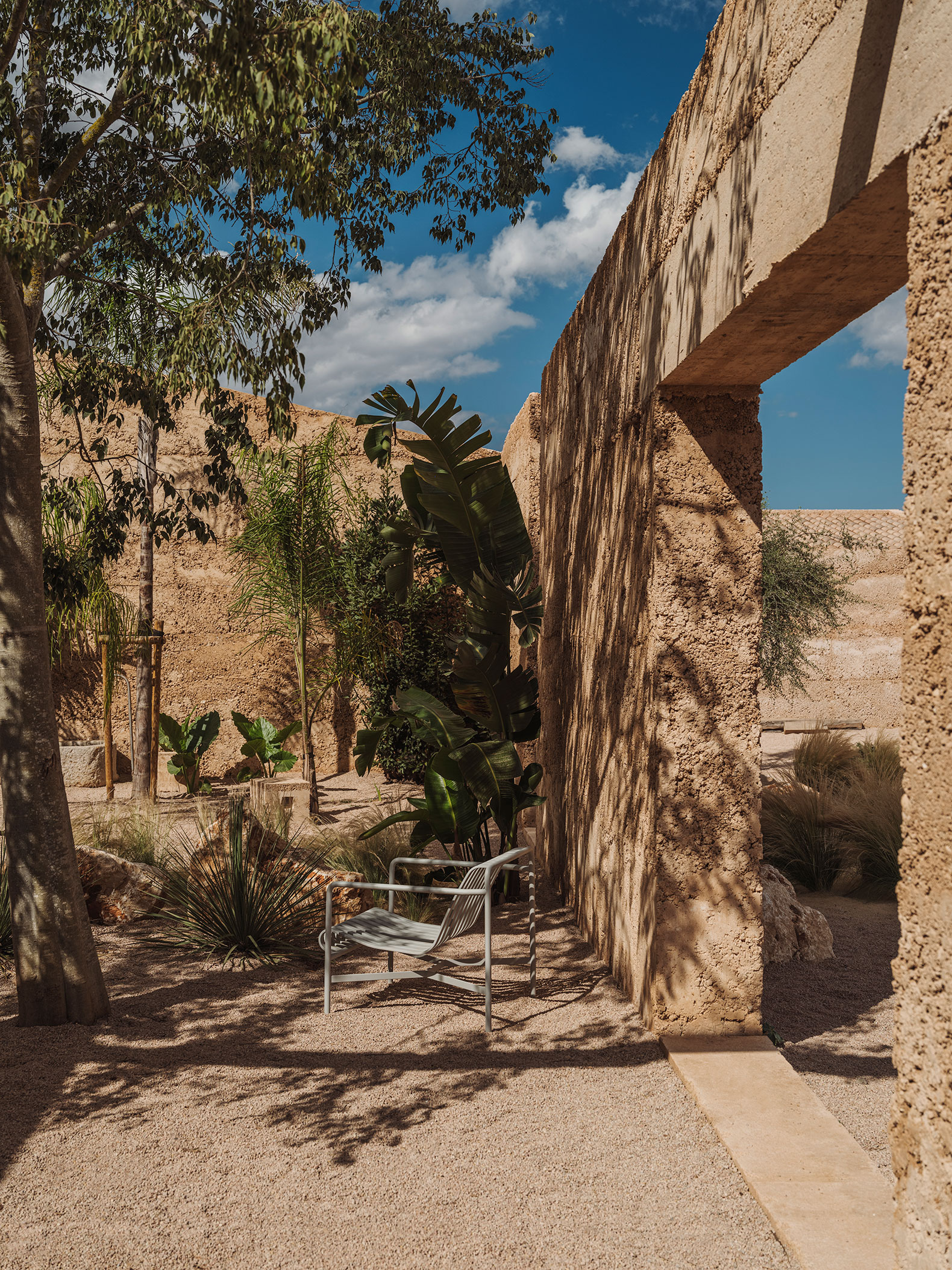
With this project, the Munarq Arquitectos reinterprets and updates the traditional typology of the courtyard house in Mediterranean architecture, and assumes the concept of the courtyard as an oasis where people meet and socialize, creating a space protected from external elements such as wind and sun. This space functions as a second public living area, which also provides a feeling of intimacy.
The construction system uses ballast walls for its structure, which also help regulate interior temperatures, thanks to their large mass and thermal inertia. In addition, wood fiber insulation and local ceramic bricks are incorporated, improving energy efficiency. The interior partitions are finished with a coating made with a mixture of earth and lime, which makes it easier to regulate humidity levels.
Regarding the roof, the criterion of using natural and renewable materials is followed, applying large blocks of straw between the laminated wood beams, which offer excellent insulation properties, creating a dense and well-integrated layer that minimizes heat loss.

Ca Na Pau by Munarq Arquitectos. Photograph by Ricard Lopez.
Project description by Munarq Arquitectos
Land oasis
Ca na Pau is a habitat designed from the available resources, in this case, a specific type of land that exhibits excellent cohesion, used to build all the walls of the house. The project starts from the material as a fundamental base. At the heart of the design process is the conviction that architecture should not impose itself on its surroundings, but should emerge from it. The house was inspired by nature, allowing the environment to guide the choices of materials and techniques.
The idea of an oasis arises from the need for protection from the vastness of the countryside, the wind and the sun, as well as the intention to continue the tradition of the patio in Mediterranean architecture
Living in the country
Living in the countryside means being exposed to the elements and having a feeling of spaciousness. To counteract this, the house incorporates the concept of a patio, with a surface area equal to that of the main house.
This carefully designed space adapts to changing needs, serving as an oasis where people can gather, reflect and relate.

The spaces not only frame the surrounding landscape, but also invite natural light to filter through, enhancing the ambiance and creating a dynamic interaction between the interior and exterior environments.
Patio
The patio creates a hierarchical space meant to be occupied, conceived as a versatile boundary where various situations can occur.
It is a sheltered enclosure, protecting from the sun, the wind and the vastness of the land, enclosing it in a semi-closed space while opening up gaps that offer views.
The void creates a space that functions as a second living area, more public, but still providing the necessary privacy.
This spatial dichotomy evokes the memory of a roofless house, worn down by the passage of time.

Ballast
The construction system is based on ballast walls (earth mixed with aggregates of various sizes, stone and lime). For the interior enclosure walls, the ballast is 25 cm thick, with 10 cm of wood fibre insulation and a 20 cm thick local ceramic brick wall. Waterproofing is achieved with an open diffusion membrane placed between the two walls to ensure the breathability of the enclosures.
The ballast walls represent a sustainable and innovative approach to construction, taking advantage of natural materials to create effective and durable structures. The use of earth mixed with aggregates and lime not only provides structural stability, but also contributes to the thermal mass, helping to regulate interior temperatures. The inclusion of wood fibre insulation improves the building’s energy efficiency by reducing heat loss and improving comfort. Local ceramic bricks add an additional layer of thermal protection and durability.

Interior earth cladding
Inside, the partitions are clad with a mixture of earth and lime, creating a hygrothermal environment favourable to our humid climate. This traditional technique not only improves the building’s thermal performance, but also contributes to better indoor air quality by regulating humidity levels. This approach not only improves energy efficiency, but also reduces the risk of mould and condensation, making it particularly suitable for regions with high humidity. Furthermore, the use of local materials aligns with sustainable building practices, offering both environmental and economic benefits. The earth and lime mixture acts as a natural buffer, absorbing and releasing moisture to maintain a comfortable and stable indoor climate.
Straw insulation
The roof is insulated with 35 x 40 x 80 cm straw blocks, which are placed between laminated timber beams. This configuration creates a dense, well-integrated insulation layer that provides superior thermal performance to 30 cm of extruded polystyrene. Straw blocks not only offer excellent insulation properties, but also contribute to sustainable building practices by using natural and renewable materials. The combination of straw and laminated timber improves the overall energy efficiency of the building, helping to regulate indoor temperatures effectively.
The straw blocks, sandwiched between the beams, form a robust thermal barrier that minimises heat loss and improves indoor comfort. In addition, this natural insulation material supports humidity regulation and breathability, crucial for maintaining a healthy indoor climate. The use of straw aligns with green building principles, reducing reliance on synthetic materials and decreasing the building’s environmental impact. This method also contributes to the durability of the building, as straw is strong and effective in creating a comfortable living environment while promoting sustainable building practices.
































































